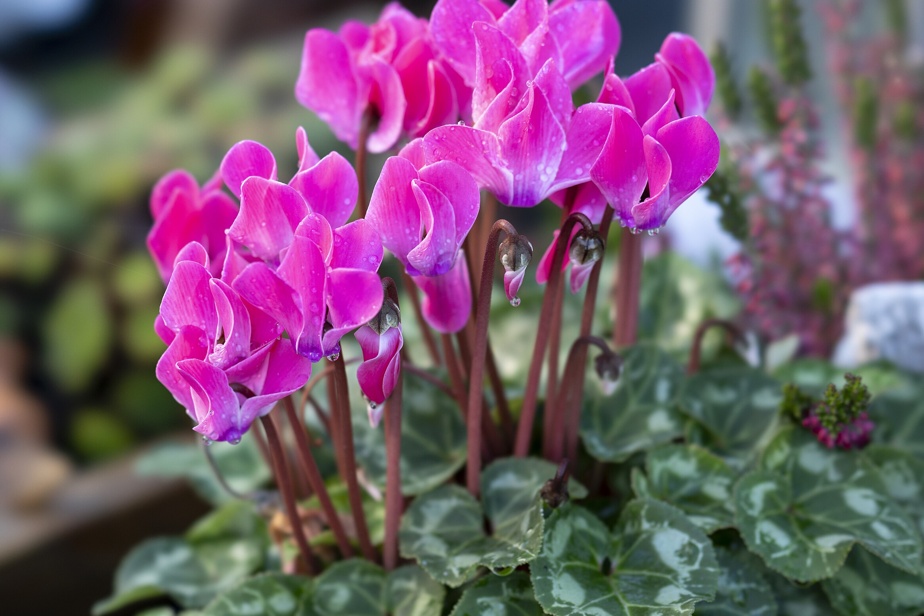Treat baldness

PHOTO DR PICS24, GETTY IMAGES/ISTOCKPHOTO
In the language of flowers, the cyclamen symbolizes sincere love. It’s hard to resist its charm.
A source of inspiration for several painters of the great Flemish school, the cyclamen was, it is said, also among the favorite flowers of Leonardo da Vinci who illustrated some of his manuscripts. Used since the 16th centurye century, the term of Greek origin refers to the circular shape of the bulb. Strangely, the cyclamen began its existence in the feminine and gradually moved to the masculine. As was often the case at the time with plants, strange potions were made from them, notably to promote childbirth, to fall madly in love or even to avoid baldness, which is all the more intriguing. that leaves and bulbs are toxic. I might as well tell you, I have never tried the experiment!
There are around twenty species of cyclamen, but those found all over the world in the form of flowering pots are the hybrids of Cyclamen persicum. Another incongruity, because if the plant is native to the Mediterranean and the Middle East, it would not exist in Iran.
If the Persian cyclamen has been appreciated for many moons, it was only during the 1970s that we witnessed the appearance of a host of hybrids with colors each more spectacular than the other and formats very variable, including the popular “minis”. The sector is still in turmoil if we rely on the new products that still appear every year. Moreover, this cousin of primroses represents an annual global market of 18 billion. Popular, they said!
Reproduced by seed

PHOTO BERTH FRANCE, TAKEN FROM WIKIMEDIA COMMONS
Not only are their colors innumerable, but some cyclamen flowers are two-tone or have pleated petals giving them a bit of a butterfly look.
There are hundreds of cyclamen cultivars today. Their flowers, which sometimes resemble a butterfly, display countless colors varying from pure white to various tones of red, pink or even purple, or reveal two colors. Several varieties have a bright red center, which perhaps explains why the plant symbolizes true love in Japan.
If most bulbous plants are reproduced by propagating bulbs, cyclamen are produced in greenhouses from seedlings, a process which requires 29 to 32 weeks to obtain flowering, a production that has become hyper-specialized. Moreover, patient amateurs can try the experiment themselves, but will then have to wait much longer, at least 18 months, before seeing the final result.
Freshness and summer vacations

PHOTO YEHUDIT GERINKOL, FROM WIKIMEDIA COMMONS
Cyclamen is the subject of international trade worth billions. The French house Morel, one of the pioneers in the field, has been producing it for 125 years and serves 70 countries with more than 300 varieties.
As is the case with most domesticated plants, particularly those of the holiday season, they always need a little love so that they are willing to offer us their beauty for as long as possible.
Cyclamen requires coolness (15°C to 20°C), bright light without direct sun and slightly moist soil. Water only when the surface of the pot is dry. Simply place the plant for twenty minutes in a saucer filled with water. Once the bath is finished, throw away the excess water.
Moreover, the main cause of mortality in cyclamen is excess watering.
Obviously, if you install it in a poorly lit place, near a heat source and bathe it as if it were a goldfish, you will quickly regret your purchase. If there is a short-term lack of water, the foliage will begin to wilt; but if you water him in time, it will be enough to perk him up. We will understand, however, that there is a limit to this type of resurrection!

PHOTO TONY HIGETT, FROM WIKIMEDIA COMMONS
Not only are their colors innumerable, but some cyclamen flowers are two-tone or have pleated petals giving them a bit of a butterfly look.
After weeks of continuous spectacle, your cyclamen will undoubtedly begin to show a certain weariness. After this long flowering, the plant will need a well-deserved rest. The foliage will usually eventually die back and fall dormant. Then stop watering for two or three months.
When summer comes, place your cyclamen outside, in the shade, for the summer holidays. This is a good time to transplant it into a slightly larger pot, as it will undoubtedly have gained a little beneficial weight. You can then start watering again if nature does not do the job. This will also be an opportunity to give it a dose of slow-release fertilizer. These little touches will make your cyclamen a happy plant that should delight you for years to come.
A real indoor conifer

PHOTO SCISETTIALFIO, GETTY IMAGES/ISTOCKPHOTO
Golden cypress gives off a lemon scent.
Small conifers are always in vogue at Christmas time. Unfortunately, live mini-spruces and firs are usually condemned to certain death within a few weeks, as the araucaria or Norfolk pine requires humidity that is very difficult to maintain in the house. One of the rare conifers that easily adapts to cohabitation is the “Gold Crest” cypress, sometimes called golden cypress. To the touch, it gives off a delicious lemon smell and can live for years at home. It likes freshness, bright light without direct sun and moist soil. It will grow slowly, but surely, over time. In summer, it can be installed outside, avoiding the hot rays of the sun.
